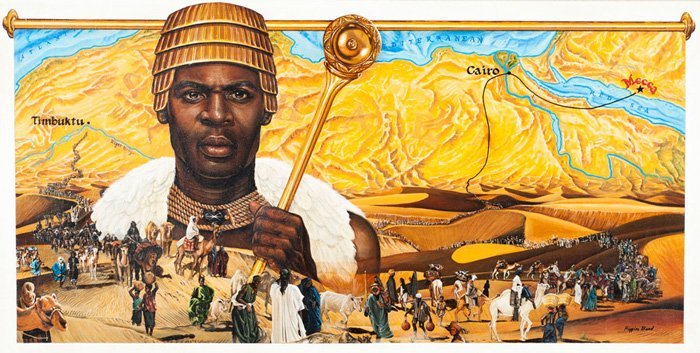Mansa Musa was the first African Muslim king to make the pilgrimage to Mecca. He was also the richest person in history, with a £321 ($400) billion fortune—much richer than Bill Gates, the Rockefellers and the Rothschild family.
Musa Keita I came into power in 1312 following the death of his predecessor, Abu-Bakr II. When he was crowned, he was given the name Mansa, meaning king. At the time, much of Europe was famished and in the middle of civil wars, but many African kingdoms were thriving.
The Mali Empire was the Old World’s biggest producer of gold, copper and salt. It encompassed vital and ancient trading hubs like Gao and Timbuktu, meaning Mansa Musa’s main income came from trading with Muslim states and other African powers at the time.

(Cresques Abraham, Public domain, via Wikimedia Commons)
His leadership of Mali, a state which stretched across two thousand miles from the Atlantic Ocean to Lake Chad and which included all or parts of the modern nations of Mauritania, Senegal, Gambia, Guinea, Burkina Faso, Mali, Niger, Nigeria, and Chad, ensured decades of peace and prosperity in Western Africa.
Mansa Musa captured the attention of the Arab world when he became the first Muslim ruler in West Africa to make the nearly four-thousand-mile pilgrimage to the Muslim holy city of Mecca in 1324. Unlike his grandfather Sundiata, Mansa Musa was a devout Muslim and knowledgeable in Arabic. This pilgrimage introduced him to rulers in the Middle East and Europe.

Preparing for the expedition took years and involved the work of artisans in numerous towns and cities across Mali. In 1324, Musa began his pilgrimage with a train of thousands of richly dressed escorts. His entourage included soldiers, civilians and slaves, 500 heralds bearing gold staffs and dressed in fine silks, and many camels and horses bearing an abundance of gold bars.
Musa made generous donations to the poor and to charitable organisations as well as the rulers of the lands his entourage crossed. On his stop in Cairo, Egypt, the Emperor gave out so much gold that he generated a brief decline in its value. It took Cairo’s gold market a decade to recover.
Musa built houses in Cairo and in Mecca to house his attendants, and as he travelled the world, a lot of people, notably the merchants of Venice, saw him in Alexandria and returned to Italy with tales of Mansa Musa’s ridiculous wealth. This helped create the myth in the minds of Europeans that West Africa was a land of gold, an El Dorado.
Upon his return from Mecca, Mansa Musa brought Arab scholars, government bureaucrats, and architects. Among those who returned with him was the architect Ishaq El Teudjin, who introduced advanced building techniques to Mali.
Material riches weren’t the king’s only concern. As a devout Muslim, he took a particular interest in Timbuktu, which was the largest city in the empire. He urbanised the city of Timbuktu by building schools, mosques, and a major university.
Ishaq El Teudjin designed numerous buildings for the Emperor, including a new palace named Madagou, the mosque at Gao, the second-largest city in Mali, and the still-standing great legendary Djinguereber Mosque in Timbuktu.
The awareness of Musa by other Islamic leaders brought increased commerce and scholars, poets, and artisans, making Timbuktu one of the leading cities in the Islamic world during the time when the most advanced nations from Spain to central India were Muslim. Timbuktu was clearly the centre of Islamic Sub-Saharan Africa.
Musa’s pilgrimage to Mecca also brought Mali to the attention of Europe. For the next two centuries Italian, German, and Spanish cartographers produced maps of the world which showed Mali and which often referenced Mansa Musa. The first of these maps appeared in Italy in 1339 with Mansa Musa’s name and likeness.
Mansa Musa died in 1337 after a twenty-five-year reign. He was succeeded by his son, Maghan I. His heirs were unable to hang on to the vast fortune, and it was substantially depleted by civil wars and invading armies.
Mansa Musa’s rich legacy persisted for generations and to this day, there are mausoleums, libraries, and mosques that stand as a testament to this golden age of Mali’s history.





